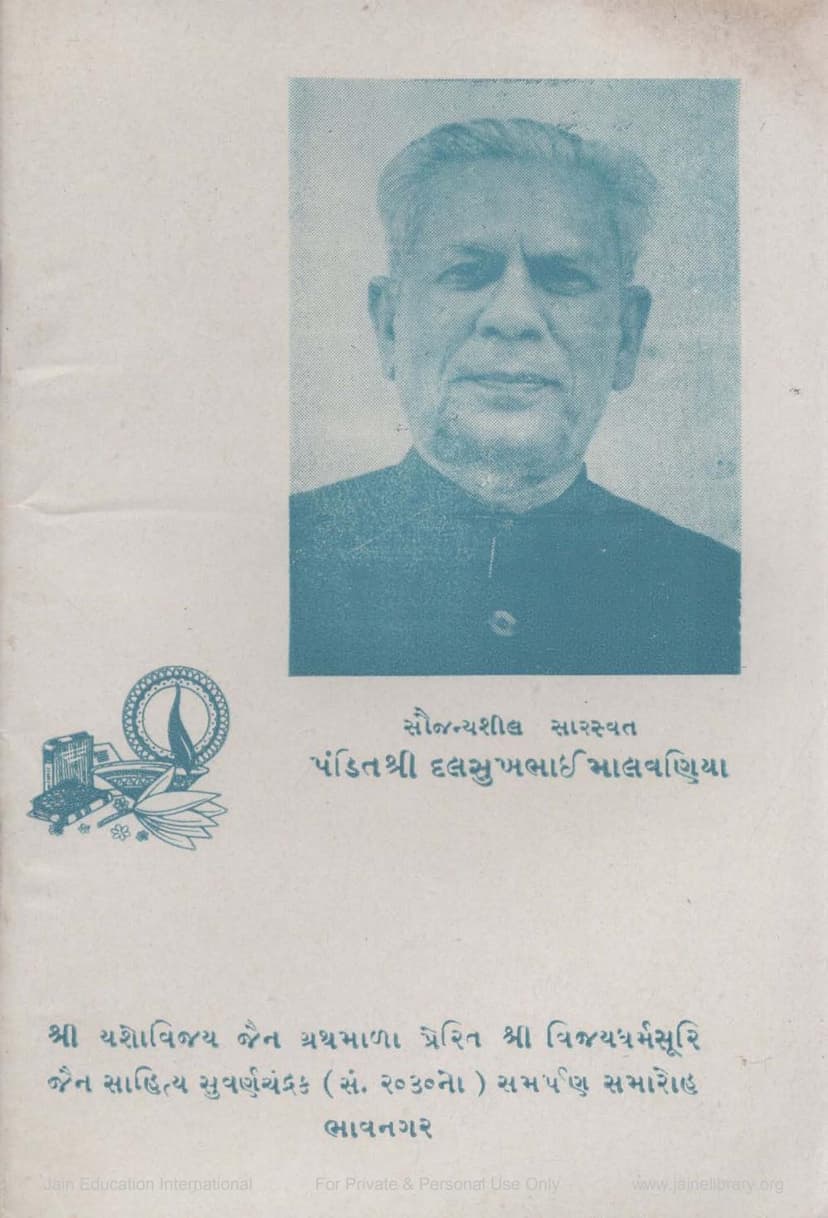Dalsukhbhai Malvaniya Pandit
Added to library: September 1, 2025

Summary
Here's a comprehensive summary of the provided Jain text about Pandit Dalsukhbhai Malvaniya:
This document is a tribute and biographical sketch of Pandit Dalsukhbhai Malvaniya, a renowned scholar, presented at a ceremony where he was awarded the Shri Vijaydharmasuri Jain Sahitya Suvarnachandrak (Gold Medal) in 1974. The publication is by the Shri Yashovijay Jain Granthamala, Bhavnagar.
The text highlights Pandit Malvaniya's deep scholarship, particularly in Jain and Buddhist philosophy, and his vast knowledge of Jain literature and scriptures. It emphasizes that his profound understanding and wisdom were achieved through dedicated self-study and a pursuit of truth, rather than solely through formal academic degrees. He is compared to the equally illustrious scholar Pandit Sukhlalji, whose student and follower Malvaniya was.
Key aspects of Pandit Dalsukhbhai Malvaniya's life and career covered in the text include:
-
Early Life and Hardship: Born in 1910 in Sayla, Saurashtra, Malvaniya came from a modest family. His father passed away when he was about ten, leaving the family in dire financial straits. His mother, Parvatiben, played a crucial role in supporting the family with her intelligence and courage. He spent seven years in an orphanage in Surendranagar, where he completed his education up to the fifth standard in English, further fueling his passion for knowledge by reading books from the ashram's library. He demonstrated an early inclination towards thoughtful reading and analysis rather than rote memorization.
-
Formal Education and Training: Malvaniya received his higher education at the Sthanakvasi Jain Training College in Bikaner (1927) and later in Jaipur and Khayavar. He was sponsored by the Bavan Gam Bhavsar Kelavani Mandal. During this period, he also studied under prominent scholars like Pandit Bhachandji, Pandit Veerabhadraji, and Pandit Velshibhai. He also had the opportunity to stay with and learn from Shatavadhani Pandit Ratnachandraji Maharaj. He earned his 'Nyaytirtha' and 'Jain Visharad' degrees in 1931.
-
Mentorship and Advanced Studies: Recognizing his potential, Shri Durlabhjibhai Tribhuvandas Zaveri sponsored Malvaniya's further studies under the esteemed Pandit Bechardasji Jivraj Doshi in Ahmedabad for Jain Agamas and Sanskrit-Prakrit grammar. This period was crucial for his intellectual development, providing him with a deep understanding of the Agamas and a critical, truth-seeking approach. He also met Pandit Sukhlalji during this time. Subsequently, Durlabhjibhai sponsored Malvaniya and others to study at Visva-Bharati, Santiniketan, under scholars like Mahamahopadhyaya Vidhushekhara Shastri Bhattacharya, where he delved into Pali language and Buddhist philosophy, and under Muni Jinvijayji for Prakrit and Jain Agamas. This immersive experience solidified his reputation as a scholar.
-
Marriage and Early Career: Malvaniya married Mathuraben in 1932. He then joined the Sthanakvasi Jain Conference's publication, 'Jain Prakash,' in Mumbai as a clerk, earning Rs. 40 per month. His wife, Mathuraben, who was also of a quiet nature, passed away prematurely in 1965, which was a significant personal loss for him. He has one son, Ramesh, and daughter-in-law Charulata, and grandchildren.
-
Association with Pandit Sukhlalji: A pivotal turn in his life came in 1934 when he met Pandit Sukhlalji in Mumbai. Panditji recognized his talent and invited him to Varanasi to work as his reader at Banaras Hindu University, despite the significant pay cut. This association proved to be incredibly beneficial, with Malvaniya becoming not just a student but also a friend and close companion to Panditji, deeply influencing his intellectual growth.
-
Academic Career Progression: After working with Pandit Sukhlalji and assisting him in his research, Malvaniya took over as Professor of Jainology at Banaras Hindu University in 1944 after Panditji's retirement. He was well-received by students and scholars alike, and even international scholars sought his knowledge.
-
Directorship at LD Institute: In 1959, at the recommendation of Kasturbhai Lalbhai, Malvaniya became the Director of the Lalbhai Dalpatbhai Bharatiya Sanskriti Vidyamandir in Ahmedabad. He served there for seventeen years, significantly enhancing the institution's reputation and its reach nationally and internationally. Even after his retirement due to age limits in 1976, he continued to serve as an advisor.
-
International Recognition: Malvaniya was invited to teach Indian philosophy, particularly Buddhist philosophy, at the University of Toronto, Canada, in 1968, where he spent 16 months and gained significant acclaim. He also lectured at the Free University of Berlin and Sampurnanand Sanskrit Vishvavidyalaya in Varanasi.
-
Personal Qualities and Philosophy: The text emphasizes Malvaniya's humility, simplicity, lack of ego, equanimity, and selfless service. He possessed a deep respect for all philosophies and believed in integrating different viewpoints ("Sarva Darshan Abhyas karu chhu ane samanvay ni bhavna ma manu chhu" - I study all philosophies and believe in the spirit of synthesis). His scholarship and geniality complemented each other, making him a beloved figure.
-
Recognition and Awards: The text details his numerous academic positions, advisory roles in various institutions, presidencies of academic conferences, and his extensive list of published works, translations, and articles in Gujarati, Hindi, and English. The awarding of the Shri Vijaydharmasuri Jain Sahitya Suvarnachandrak is presented as a fitting recognition of his lifelong dedication to Jain literature.
In essence, the document celebrates Pandit Dalsukhbhai Malvaniya as a scholar par excellence who, through immense dedication, intellectual rigor, and humility, made significant contributions to the study of Jainism and Indian philosophy, earning him widespread respect and accolades.